
Purpose
When someone with aphasia has difficulty saying a word, it’s not always obvious how much of that difficulty stems from a motor speech problem such as apraxia of speech and how much is due to a difficulty retrieving the sound of the word internally (internal phonology). In order to assess this, we need to require the person to generate the sound of the word internally, but without requiring them to say it. Generating phonology for output is the last stage of processing before spoken word production, and it’s very different from input judgements of phonology such as same/different judgements.
In the Rhyme Judgement task, the name of the picture at the top rhymes with one of the three pictures at the bottom. In the example pictured above, pear rhymes with chair. By default, the exercise provides the sound of the word for the top picture, but not for the target picture. If the person is able to select the target picture (the one that rhymes), it indicates that they are able to access the sound of that target word internally, even if they’re unable to say it. This indicates that there is a discrepancy between output phonology and spoken output – a discrepancy which might indicate a motor speech component to the problem.
This module is useful not only for initial assessment of the integrity of output phonology, but also for monitoring change as therapy progresses.
Note that in many cases (including the example above) it’s not possible to make the decision on the basis of similarities between written forms of the words alone. The word beer looks as similar to pear as does chair.
Configuration options
By default (format RJ1), you will hear a spoken question which provides the name of the top picture, in this case “pear rhymes with…..”. Consequently the person is required to access only one of the two words making up the rhyme pair. If you want to make the task harder you can set it to require the person to access both words.
Format RJ2 presents the question in written form only, meaning that the person can see the name of the top picture but cannot hear it.
Format RJ3 does not provide a question at all. This means the person has to generate in full the word forms of both members of the rhyme pair.

If you want to be quite sure that the person isn’t making judgements on the basis of the similarity of the written words, go into the exercises settings, select sets and tap “spelling doesn’t betray rhyme”. This will select only questions in which the spellings of the two members of the rhyme pair are too different from each other to serve as a useful basis for judging whether they rhyme.